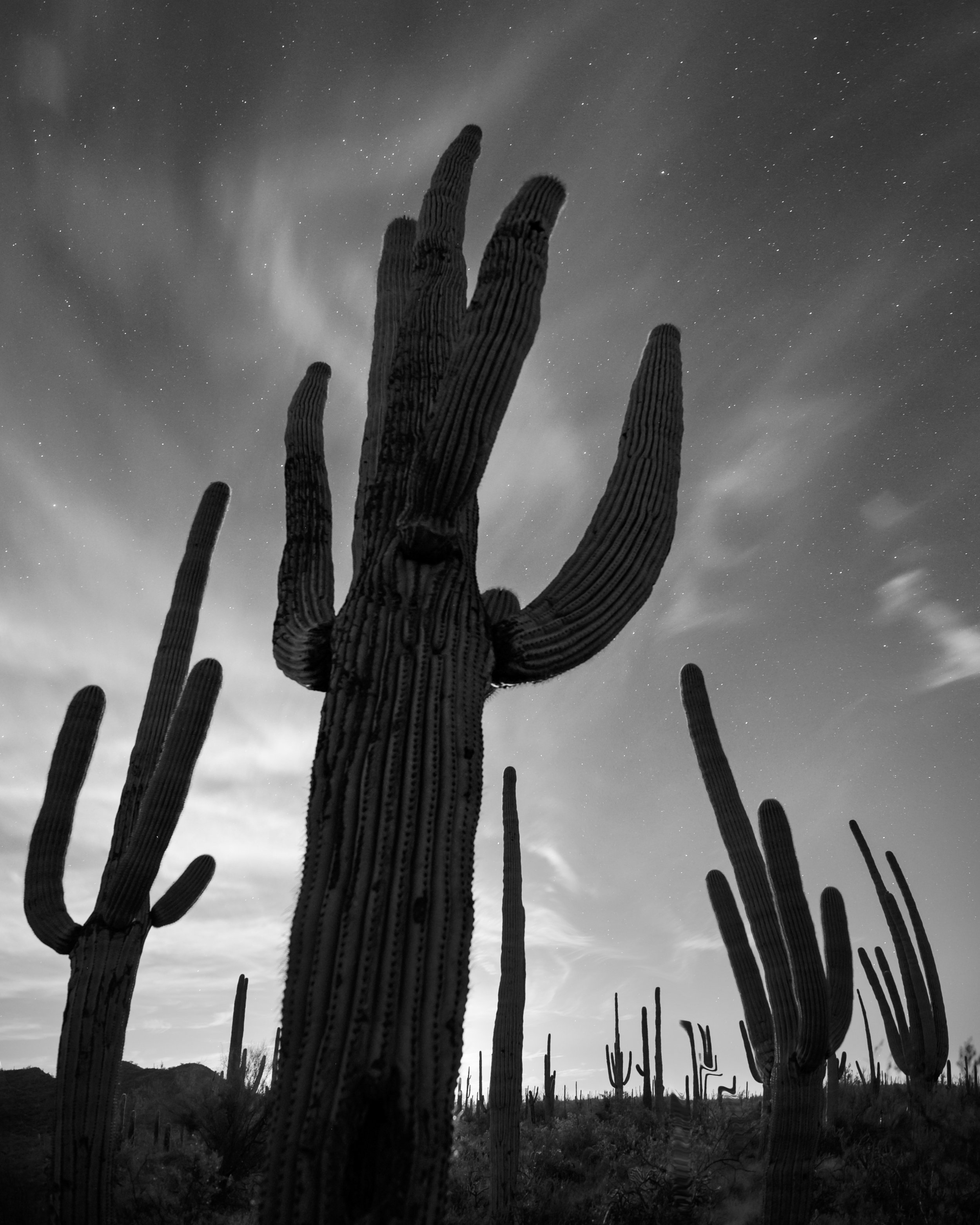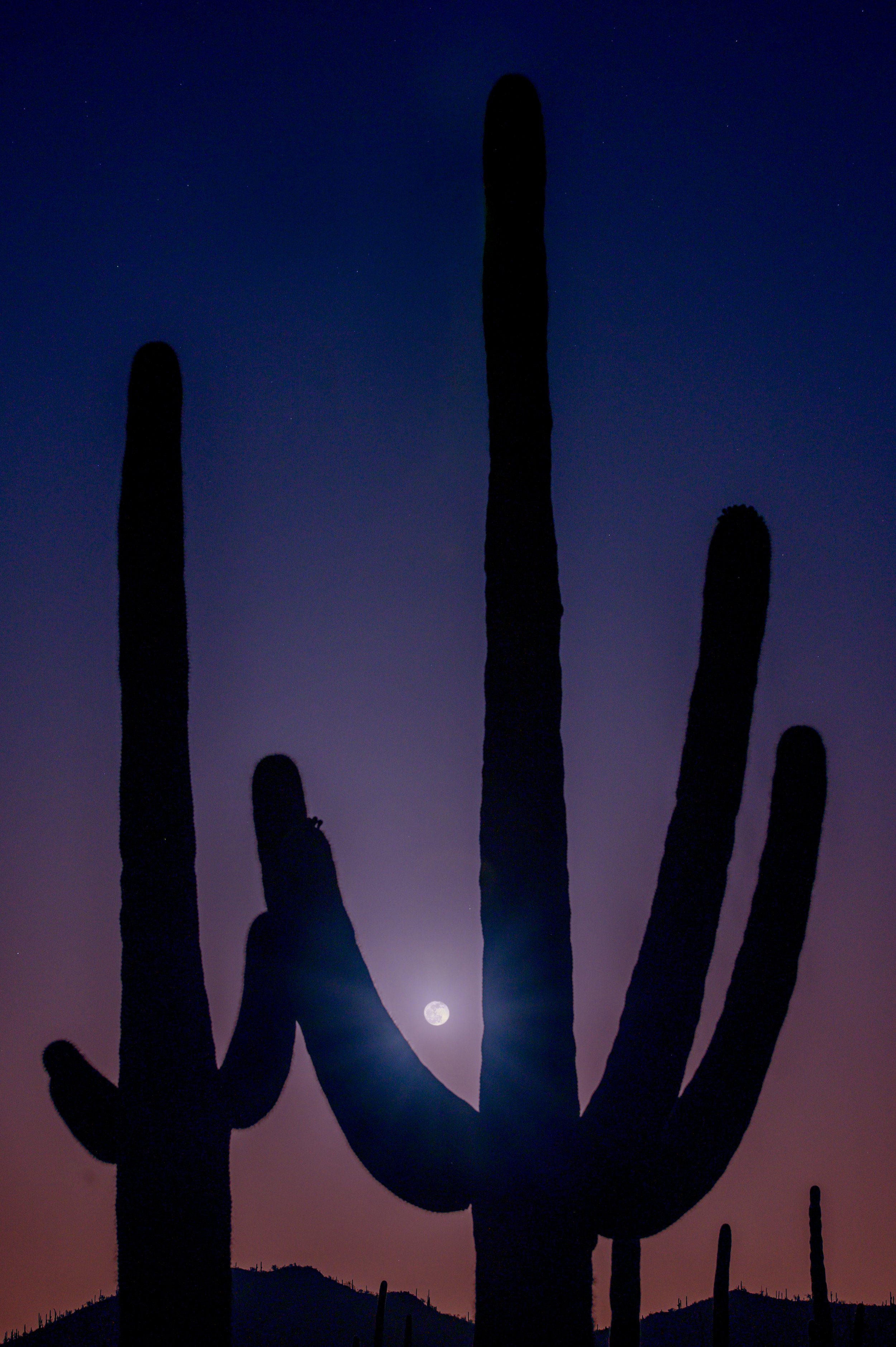Saguaro National Park
Deep in the Arizona desert stands a forest of cactus that can reach heights of 60 feet. The distinctive saguaros, silently spreading across the landscape, reach for the stars and the heavens beyond. Barrel, prickly pear and teddybear cholla cactuses also adorn the arid foreground, while foxes and coyotes dart in and out of the moonlight shadows. We'll photograph it all (and more) on 5 spring nights in the Sonoran Desert.
Workshop Details
April 4-9, 2023— Completed
This is a 5-night, 6-day workshop. Your adventure begins on the morning of April 4 and ends after a final slideshow on the afternoon of April 9.
$2,195 + applicable taxes. Register below.
Skill level
Open to all who have an understanding of the basic principles of photography and of their cameras.
Group size
14, with 2 instructors — 7:1 ratio
NPS website
Our workshop mission is to explore every U.S. national park. As with all our Passport Series locations, it may be years (if ever) before we return to any specific park. If you have a dream of making epic long exposures at night at Saguaro, we hope you join us.
Workshop Leaders
Registration
This event has passed. Thanks for your interest
| • Deposit of $600 is required to reserve your spot at the workshop. |
| • Balance of $1,595 is due on January 4, 2023. —> Pay balance here. |
| • You may choose the “Pay in Full” ticket if you desire to pay all at once. |
| • Last day for a cancellation request is January 3, 2023 (see cancellation and refund policy). |
| • The workshop fee does not include lodging, food, airfare, entrance fees, or transportation to Tucson or to our nightly shoot locations. |
The Saguaro Experience
Saguaro National Park is named for the abundance of our country’s largest cactuses. But, while the iconic cactus dominates the scene, the Sonoran Desert provides a bounty of other photographic beauty. From stunning sunsets over stately saguaros to beautiful blooms of the barrel, hedgehog cholla and prickly pear cactus.
This five-night, six-day photography workshop takes place during Saguaro’s early spring season. This increases our chances of catching the cactuses in bloom as well as avoiding the summer heat. Clear skies and cooler nights make this a great month to visit. We’ve planned this workshop to coincide with a moon phase that allows us to capture the rising full moon over the mountains and saguaros. This phase will also allow us to see the magnificent forests under moonlight, as well as capture the Milky Way a little later in the week.
Most early afternoons will find us sharing and learning and sharing in the classroom with lectures or image reviews, while evenings and nights will be spent shooting in the field. Sunsets are one of the most beautiful aspects of the park, so we’ll be out in time to capture them as well as the night sky.
This workshop is for anyone who is interested in exploring Saguaro’s unique landscape while gaining a deeper understanding of night photography. Making new friends, learning new techniques, having fun and bringing home some epic images is guaranteed!
What You Should Know
Participants must have at least basic photo skills, know their cameras well, and be comfortable shooting RAW in manual mode with a DSLR or high-end mirrorless camera.
Night photography experience is not necessary, but even folks with extensive experience shooting at night will find this workshop challenging, stimulating and inspiring. For more advanced night photographers, we can offer a portfolio review and specific challenges and goals, and will offer guidance in the field if you mainly want to concentrate on creating portfolio images or learning more advanced techniques.
If you would like to attend this workshop but are unsure whether you have adequate night photography skills, we can offer pre-workshop tutoring to get you ready for your adventure with us. Alternatively or additionally, a few of us have written books that may be productive pre-workshop reads.
What You Will Learn
We hope to inspire you to step outside your comfort zone—to test the limits of what you and your camera can do.
TOPICS COVERED WILL INCLUDE:
star trails
shooting the Milky Way
light painting
Low-level Landscape Lighting
and more …
This workshop will have both field and classroom instruction. We will be in the classroom during the day, and out in the field at different locations each night. Participants can stay out shooting as long as they, or their camera’s batteries, hold out. While in the field, the instructors will demonstrate their own techniques and will work with participants one-on-one to make sure everyone gets the most out of the workshop.
Our locations have generous room to explore, so everyone will be able to spread out and not get in one another’s way. Each participant will have the opportunity to work one-on-one with Tim and Gabe in the field.
We do not tell our attendees what to photograph, and we won’t line you up in a row to all shoot the same thing (unless it’s helpful to get some people on track). Instead, we encourage you to use what you have learned to create your own unique images, and to let us guide you through the process should you desire.
Night Conditions
Logistics & General Info
Travel
You are responsible for arranging and paying for your own transportation.
Rental Car
You will need a rental car.
There is no need for four-wheel-drive.
If you are interested in carpooling or sharing a rental car, let us know and we will try to connect you with another attendee looking for the same.
Nearby Airport:
Tucson (TUS) — 20 minutes from hotel
Lodging & Food
You are responsible for arranging and paying for your own accommodations and meals.
Lodging
You are not required to stay at the official workshop lodging, though doing so does make it easier to meet with the group each morning.
Info and group code will be sent soon after registering.
If you are interested in sharing a room, let us know and we will try to connect you with someone like-minded in the group.
Food
Tucson has plenty of good nearby food options.
We encourage eating two meals per day—a good breakfast and a great late lunch.
When on the night shoots, you may wish to bring snack food or a sandwich and plenty of water.
Weather
Expect daytime highs in the low 80s F, lows in the high 50s.
Recommended Attire
Shorts or pants and short-sleeve shirts for daytime, pants and long-sleeve shirts for night.
A sweatshirt and medium-weight jacket will likely be useful, and a base layer might not be a waste of packing space. Layers are good.
Comfortable and protective shoes are recommended for getting around. There won’t be long hikes, but we will be on trails, so quality trail shoes or hiking boots would be optimal.
Exertion Level
The exertion level of this workshop is Easy. (See more about our classifications.)
No vigorous activity will be required during the workshop, but please consider your physical abilities prior to registering. There won’t be any long hikes, but we will be doing short hikes on unmaintained trails, and you should be comfortable carrying your own equipment over uneven ground in the dark.
Considerations
Please read our FAQs section for more information about skill and gear requirements, and other information that pertains to all our workshops.
If you have questions, please contact us—we're happy to talk it over with you.
Nights, Deserts and Cactuses in the West …
“Then I saw the saguaros up close. They were like people. Each with their own personalities.”
Over the years I have been fortunate to spend a lot of time in the western deserts. From the higher Great Basin deserts in Utah to the lower Mojave of California and the Chihuahuan of Texas. I’ve seen plenty of javelinas and been pricked by more than a few cactuses, agaves and yuccas.
In all of these years, however, I had never made it down to see the most iconic of all desert plants: the saguaro. I finally decided to rectify the situation.
Being a photographer, I usually imagine a location through the eye of a lens. Some places have a quiet beauty, others a rugged beauty. Some places have the sort of beauty that I appreciate but may not care to photograph. When I was planning my trip to Saguaro National Park, I was not quite sure what I would encounter. Cactus? Check. Sunset? Check.
But what else did it have to offer? Loads!
On my first drive into the park from our hotel in Tucson, I was immediately impressed with the area outside the park. I was not even in the park proper yet and I was already taking mental photographs. Then I saw the saguaros up close. They were like people. Each with their own personalities. We began naming them and calling out what they reminded us of. It was a game we played our entire trip. And it never got old.
Once I spent some time getting to know the cactuses I was able to look past them and see their incredible home. The Sonoran Desert they live in is the only one of the four desert types in the U.S. that doesn’t experience cold winters. This means the flora of the Sonoran Desert is quite abundant with succulents and other cold-sensitive species. And April and May are the time for them to crown. From ocotillo to barrel cactus to the caps of blooms on the saguaros themselves, I was able to witness the vibrant life that can appear in this harsh environment.






























